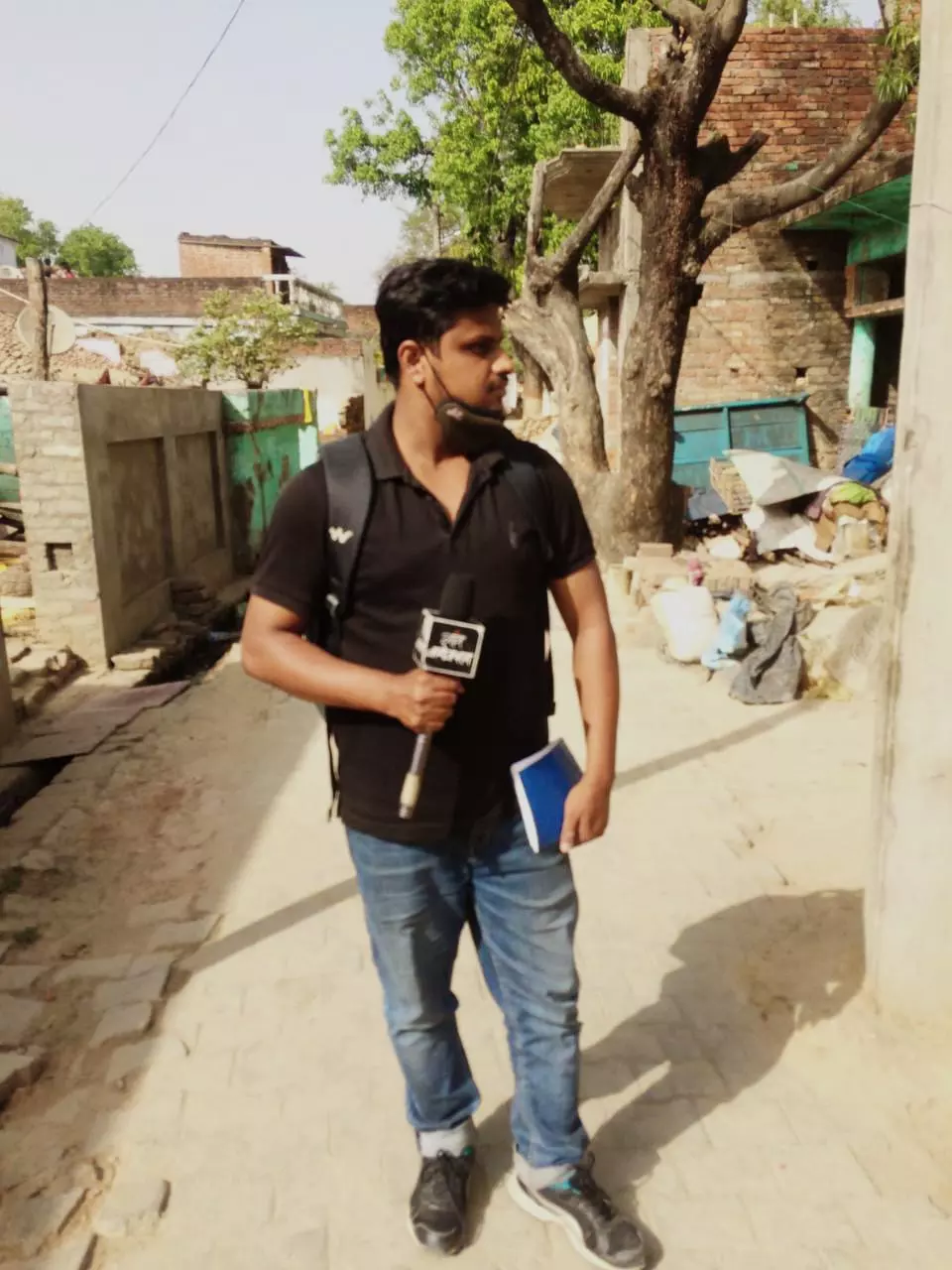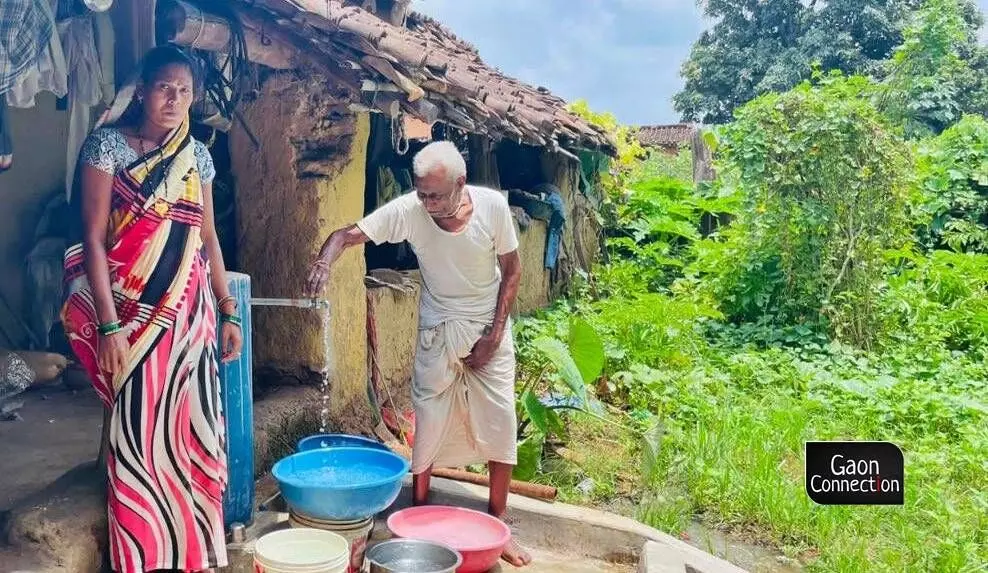Having missed the December 2022 deadline, will all households in Bundelkhand, UP get tap water by Diwali?
Uttar Pradesh government is working on a war footing to provide the promised tap water connections in every household of the seven districts of the rain-deficient Bundelkhand region by this Diwali.
 Pratyaksh Srivastava 29 Sep 2023 11:40 AM GMT
Pratyaksh Srivastava 29 Sep 2023 11:40 AM GMT

Water from two major rivers — Betwa and Yamuna — were utilised to supply water to the filtration plants and provide tap water to rural households in the Har Ghar Jal scheme.
Mahoba and Jhansi, Uttar Pradesh
Decades ago, Kusuma came to Shivhar as a young bride. The village in Mahoba district of Uttar Pradesh falls in the Bundelkhand region which is notorious for water scarcity and recurring droughts.
“I spent all my life making several trips to fetch water by carrying three pots at one time,” 70-year-old Kusuma told Gaon Connection. “My bahu [daughter-in-law] is lucky we have a tap at home now,” she added.
The tap that has brought relief to Kusuma’s family in their village, which is located 230 kilometres southwest of the state capital Lucknow, has been installed under the Union government’s Jal Jeevan Mission.
Like Kusuma, hundreds of thousand families in the rain-deficient Bundelkhand region are being provided piped water supply under the central government’s flagship programme. Jal Jeevan Mission - Har Ghar Jal scheme aims to provide safe and adequate drinking water through individual household tap connections by 2024 to all households in rural India.
However, in the case of Bundelkhand region — comprising seven districts (Jhansi, Jalaun, Lalitpur, Mahoba, Hamirpur, Banda and Chitrakoot) of Uttar Pradesh (UP), and six districts (Datia, Tikamgarh, Chhatarpur, Panna, Damoh and Sagar) of Madhya Pradesh — the UP government had promised to provide tap water in every rural household of the seven districts of Bundelkhand by December 2022.
हर घर जल पहुंचाना ही है सरकार का मुख्य उद्देश्य#HarGharJal #safedrinkingwater #SWSM #pipewatersupply pic.twitter.com/2O44Y8XpMg
— State Water & Sanitation Mission, Uttar Pradesh (@swsmup) July 22, 2020
Also Read: A Midsummer Pipe Dream: Pipelines laid down and taps installed, but where is the water?
But, that deadline has been missed and nearly a year later, the state government is working on a war footing, hoping to achieve the target by November this year.
“We are fully committed to achieving this target. The seven districts in Bundelkhand will have water connections in all the rural households by this Diwali,” Anurag Srivastava, Principal Secretary in the state government’s Namami Gange and Rural Water Supply Department, told Gaon Connection.
Giving reasons for missing the December 2022 deadline, Srivastava said that COVID-19 slowed things down considerably. “Also, the groundwater availability in this region is amongst the poorest in the state,” he said.
Water from two major rivers — Betwa and Yamuna — were utilised to supply water to the filtration plants and provide tap water to rural households in the Har Ghar Jal scheme. “Almost 90 per cent of the water for the project has been sourced from the rivers while only 10 per cent has come from groundwater,” the principal secretary said.
On September 27, earlier this week, according to the Jal Jeevan Mission dashboard, 95.07 per cent of the rural households in Jhansi district were already connected with tap water supply. In Mahoba district, 97.55 per cent of households were connected, Lalitpur had 96.35 per cent connectivity, and Banda had 92.91 per cent coverage. In Jalaun, 84.78 per cent of households had tap connections and in Hamirpur it was 80.16 per cent. The percentage stands at 89.58 per cent for Chitrakoot.
About 100 kilometres away from Shivhar village, is Purwa in the neighbouring Jhandi district. Earlier this month, on September 16, bureaucrats and media persons thronged this village on a familiarisation visit to a water filtration plant there, which has been set up under the Har Ghar Nal scheme.
“Many laal batti sarkaari gaadi [government vehicles with beacons] have been coming to our village to oversee the filtration plant. The plant has provided us with tap water connections for two months which ensure two hours of water supply in a day,” Kalka Prasad, a 55-year-old resident of the Purwa village, told Gaon Connection. Before this Kalka Prasad and his fellow villagers depended on hand pumps for water.
There are 42 water filtration plant projects in the Bundelkhand region of Uttar Pradesh. Keeping in view the arid conditions of the Bundelkhand, the water intake for these projects is not more than 10 per cent of the minimum discharge of Betwa and Yamuna rivers at a given location.
Also Read: Bundelkhand: Water crisis drives villagers into becoming climate refugees
According to Ranvijay Singh, the executive engineer from Jhansi’s Jal Nigam under the Har Ghar Jal scheme, 55 litres of potable water per person per day was the quota as directed by the Jal Jeevan Mission scheme.
The UP government now plans 100 per cent coverage of tap water supply in the seven districts of Bundelkhand by the end of the year.
Initial hiccups
Whereas villagers are happy to finally have a tap water connection at their homes, there are still reservations about the quality of water that they get from their taps.
“We do not depend on tap water for drinking. For that we use the water from the handpump. We only use tap water for washing and other chores,” Sukhpal Singh of Purwa village told Gaon Connection. He added that the tap water supply was erratic and was available to them at best for two hours in the mornings and sometimes in the evening.
Kalka Prasad repeated the same: “I still fetch water from the hand pump for drinking. I think it is safer.”
The UP government now plans 100 per cent coverage of tap water supply in the seven districts of Bundelkhand by the end of the year. Photo by Pratyaksh Srivastava
Such misconceptions prevail in Shivhar village of Mahoba as well. “There is water that comes in the tap, but it is often yellowish or whitish in colour and we don’t feel safe drinking it,” Happy, a 16-year-old student of class nine in Shivhar, told Gaon Connection.
Ayush Singh, executive engineer from the State Water and Sanitation Department, told the villagers that the whitish colour of the water was because of the pressure with which water came to the taps from the filtration plant.
“The pressure results in small air bubbles which are temporarily formed when water is poured into the glass or a bottle. After a few minutes, the water returns to its original colourless form,” said Singh.
Principal Secretary Anurag Srivastava briefing the press about the implementation of Jal Jeevan Mission scheme in Bundelkhand. Photo by Pratyaksh Srivastava
Principal Secretary Srivastava said getting the village inhabitants to trust the tap water was a challenge in itself but the state and district administrations were working on it.
“We are running awareness programmes and have roped in many NGOs [non-governmental organisations] to do the same. There are places where excessive use of chlorine has discoloured the water. The matter will be resolved once the trial runs are over,” the officer assured.
“By November, this year, these issues will be resolved,” Srivastava promised.
More Stories




